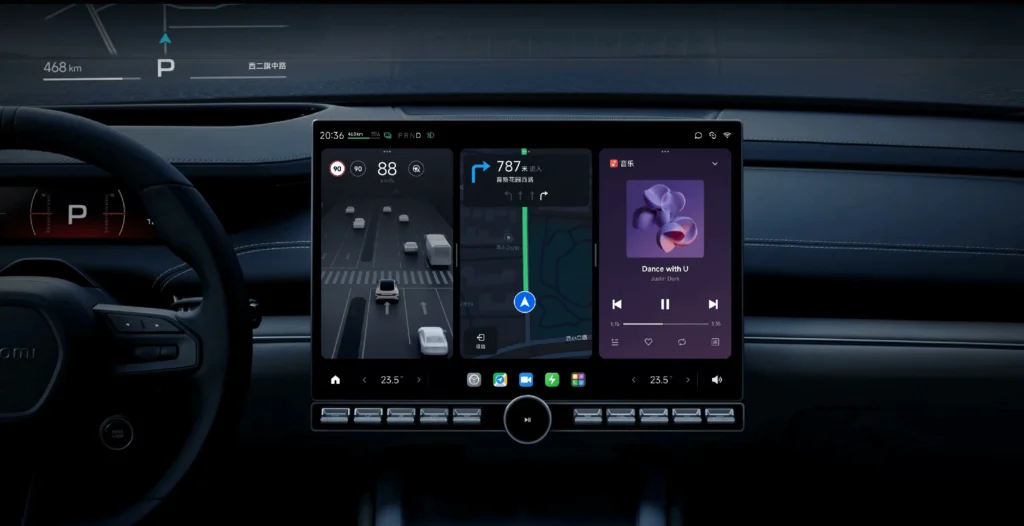Understanding Automotive-Grade Displays
An automotive-grade display is a screen designed and manufactured to meet the rigorous demands of the automotive industry. Unlike consumer devices such as smartphones or tablets, vehicle environments are harsh:
- Wide temperature variations (from winter cold to summer heat).
- Constant vibration and shock.
- Long product life cycles (10+ years).
- Strict safety and reliability standards.
Therefore, automotive-grade displays must combine robust durability, stable performance, and compliance with international automotive standards.
Why Standard Consumer Displays Aren’t Enough
Consumer electronics panels focus on cost-effectiveness and short refresh cycles. They may work well indoors but fail quickly in a car due to:
- Limited temperature tolerance (typically 0°C to 40°C).
- Lower brightness unsuitable for direct sunlight.
- Short product lifetimes (2–3 years).
- Insufficient vibration resistance for road conditions.
By contrast, automotive-grade displays are engineered for long-term, mission-critical performance.
Key Characteristics of Automotive-Grade Displays
Wide Operating Temperature Range
Automotive-grade displays are built to withstand temperatures from -40°C to +85°C, ensuring reliable operation in diverse climates.
High Brightness and Sunlight Readability
Typical brightness levels exceed 800–1000 cd/m², combined with anti-reflective coatings, ensuring visibility even in direct sunlight.
Extended Lifespan
Designed for 10–15 years of operation, these displays far outlast consumer-grade panels.
Vibration and Shock Resistance
Displays undergo rigorous mechanical testing to ensure they can survive road vibration, engine resonance, and impacts.
Wide Viewing Angles
With IPS or advanced TFT technology, displays maintain clear readability from multiple driver and passenger angles.
Functional Safety Compliance
They often support ISO 26262 standards, meaning display failures won’t compromise vehicle safety.
Industry Standards and Certifications
To be considered “automotive-grade,” displays must comply with strict standards, such as:
- AEC-Q100/Q200 – Reliability standards for automotive electronic components.
- ISO 16750 – Road vehicle environmental conditions and testing.
- ISO 26262 – Functional safety requirements.
- EMC/EMI Compliance – Ensures displays do not interfere with other vehicle systems.
These certifications guarantee that a display can function under real-world automotive conditions.
Types of Automotive Displays
Instrument Cluster Displays
Replaces analog dials with high-resolution digital dashboards, often using TFT or OLED.
Infotainment Displays
Central control units for navigation, entertainment, and vehicle settings.
Head-Up Displays (HUDs)
Projects essential driving information onto the windshield for minimal distraction.
Passenger Displays
Luxury cars may include co-driver or rear-seat entertainment screens.
Each type requires specific touch ICs, brightness levels, and safety standards.
自動車用ディスプレイ設計における課題
エンジニアにとっても、自動車用ディスプレイの設計または統合には課題が伴います:
- 熱管理: 高輝度は深刻な熱負荷を生み出します。
- タッチ感度: 手袋着用時、濡れた指、またはスタイラスでの操作が可能でなければなりません。
- 供給持続性: 自動車プロジェクトでは、長年にわたる部品供給の保証が求められます。
- コストと信頼性のバランス: 手頃な価格と厳格な自動車基準との両立。
自動車グレードディスプレイの将来動向
自動車用ディスプレイ業界は急速に進化しており、以下のような革新技術が登場しています:
- OLED自動車用ディスプレイ – 更高コントラスト、深い黒色表現、柔軟な設計が可能。
- Mini-LEDバックライト技術 – 更高輝度かつ省エネルギー性に優れた画面。
- 曲面/自由形状ディスプレイ – ダッシュボードデザインとのシームレスな統合。
- 拡張現実型HUD(ヘッドアップディスプレイ) – 運転者の視界に直接ナビゲーションと安全情報を投射。
自動運転技術が進歩するにつれ、表示技術はユーザーインタラクションにおいてさらに重要な役割を果たすでしょう。
を要求すべきである
An automotive-grade display 自動車用ディスプレイは単なる一般的な画面ではなく、過酷な環境に耐え、運転者の安全を確保し、高級な車内体験を提供するために高度に設計されたソリューションです。
厳格な 信頼性、安全性、環境基準を満たすことで、これらのディスプレイは自動車産業が自信を持って よりスマートで安全没入型の運転体験.

